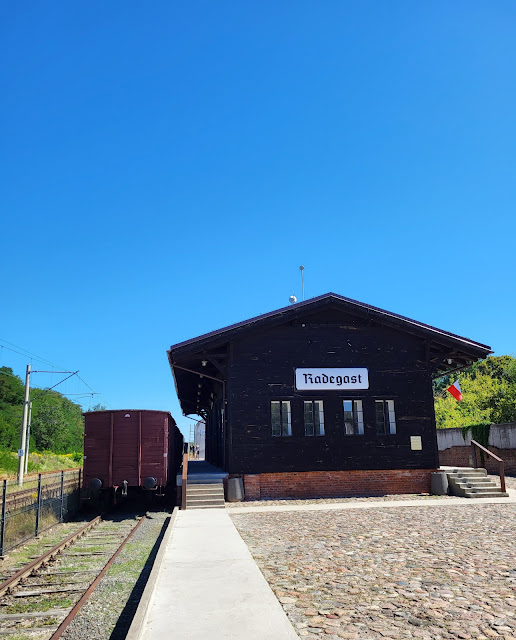Stacja Radegast w Łodzi jest zabytkowym budynkiem kolejowym z 1941 r. W czasie II wojny światowej była ona związana z gettem, utworzonym przez Niemców w 1940 r. w Łodzi (Litzmannstadt). Początkowo obiekt pełnił funkcję punktu przeładunkowego żywności i surowców, przeznaczonych dla ludności i zakładów pracy getta. Od stycznia 1942 r. stacja stała się miejscem, z którego wywożono ludność żydowską do obozów zagłady Kulmhof w Chełmnie nad Nerem i Auschwitz-Birkenau. Pomnik powstał w 2004 r. i upamiętnia Zagładę blisko 200 tys. Żydów skoncentrowanych w najdłużej funkcjonującym, a zarazem drugim, co do wielkości getcie utworzonym przez Niemców na ziemiach polskich.
Założenie pomnikowe składa się z jedynego zachowanego zabytkowego budynku magazynowego stacji Radegast powstałego w 1941 r., Tunelu Deportowanych (we wnętrzu którego prezentowane są listy transportowe ofiar Zagłady), zwieńczonego Kolumną Pamięci, w której znajduje się symboliczny Hol Miast.
Elementem pomnika są również macewy z nazwami obozów koncentracyjnych i zagłady do których deportowano Żydów z getta łódzkiego. Obok stacji stoi pochodząca z 1944 r. lokomotywa wraz z wagonami.
Radegast Station is a historic railway building from 1941. During World War II, it was associated with the ghetto established by the Germans in 1940 in Łódź (Litzmannstadt). Initially, the facility served as a transshipment point for food and raw materials intended for the population and workplaces of the ghetto. From January 1942, the station became a place from which the Jewish population was deported to the Kulmhof extermination camps in Chełmno nad Nerem and Auschwitz-Birkenau. The monument was created in 2004 and commemorates the Holocaust of almost 200,000 Jews concentrated in the longest-functioning and second largest ghetto established by the Germans on Polish soil. The monumental complex consists of the only preserved historic warehouse building of the Radegast station built in 1941, the Tunnel of the Deported (inside which the transport lists of Holocaust victims are presented), topped with the Column of Remembrance, which contains the symbolic Hall of Cities. The monument also includes tombstones with the names of the concentration and extermination camps to which Jews were deported from the Łódź ghetto. A locomotive from 1944 with wagons stands next to the station.
Der Bahnhof Radegast ist ein historisches Eisenbahngebäude aus dem Jahr 1941. Während des Zweiten Weltkriegs war er mit einem 1940 von den Deutschen in Łódź (Litzmannstadt) eingerichteten Ghetto verbunden. Ursprünglich diente die Anlage als Umladestelle für Lebensmittel und Rohstoffe, die für die Bevölkerung und Arbeitsplätze des Ghettos bestimmt waren. Ab Januar 1942 wurde der Bahnhof zum Ort, von dem aus die jüdische Bevölkerung in die Vernichtungslager Kulmhof in Chełmno nad Nerem und Auschwitz-Birkenau transportiert wurde. Das Denkmal wurde 2004 errichtet und erinnert an den Holocaust an fast 200.000 Menschen. Die Juden konzentrierten sich im ältesten und gleichzeitig zweitgrößten von den Deutschen in Polen errichteten Ghetto. Das Denkmal besteht aus dem einzigen erhaltenen historischen Lagergebäude des Bahnhofs Radegast aus dem Jahr 1941, dem Tunnel der Deportierten (in dem Transportlisten von Holocaust-Opfern präsentiert werden) und der Gedenksäule, in der sich die symbolische Halle der Städte befindet gelegen. Ein weiteres Element des Denkmals sind Grabsteine mit den Namen von Konzentrations- und Vernichtungslagern, in die Juden aus dem Ghetto Łódź deportiert wurden. Neben dem Bahnhof steht eine Lokomotive aus dem Jahr 1944 mit Waggons.






Brak komentarzy:
Prześlij komentarz